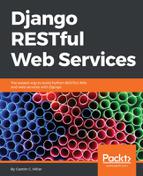Throughout this book, we will be working with different packages and libraries to create RESTful Web Services, and therefore it is convenient to work with Python virtual environments. Python 3.3 introduced lightweight virtual environments and they were improved in Python 3.4. We will work with these virtual environments, and therefore you will need Python 3.4 or greater. You can read more information about PEP 405 Python Virtual Environment, that introduced the venv module, here: https://www.python.org/dev/peps/pep-0405. All the examples in this book were tested on Python 3.6.2 on Linux, macOS, and Windows.
Each virtual environment we create with venv is an isolated environment and it will have its own independent set of installed Python packages in its site directories (folders). When we create a virtual environment with venv in Python 3.4 and greater, pip is included in the new virtual environment. In Python 3.3, it was necessary to manually install pip after creating the virtual environment. Note that the instructions provided are compatible with Python 3.4 or greater, including Python 3.6.2.
In order to create a lightweight virtual environment, the first step is to select the target folder or directory for it. The following is the path we will use in the example for Linux and macOS.
The target folder for the virtual environment will be the HillarDjangoREST/01 folder within our home directory. For example, if our home directory in macOS or Linux is /Users/gaston, the virtual environment will be created within /Users/gaston/HillarDjangoREST/01. You can replace the specified path with your desired path in each command:
~/HillarDjangoREST/01
The following is the path we will use in the example for Windows. The target folder for the virtual environment will be the HillarDjangoREST�1 folder within our user profile folder. For example, if our user profile folder is C:Usersgaston, the virtual environment will be created within C:UsersgastonHillarDjangoREST�1. You can replace the specified path with your desired path in each command:
%USERPROFILE%HillarDjangoREST�1
In Windows PowerShell, the previous path would be as follows:
$env:userprofileHillarDjangoREST�1
Now, we will create a new virtual environment with venv. In order to do so, we have to use the -m option followed by the venv module name and the desired path to make Python run this module as a script and create a virtual environment in the specified path. The instructions are different depending on the platform in which we are creating the virtual environment.
Open Terminal in Linux or macOS and execute the following command to create a virtual environment:
python3 -m venv ~/HillarDjangoREST/01
In Windows, in Command Prompt, execute the following command to create a virtual environment:
python -m venv %USERPROFILE%HillarDjangoREST�1
If you want to work with Windows PowerShell, execute the following command to create a virtual environment:
python -m venv $env:userprofileHillarDjangoREST�1
None of the previous commands produce any output. The script created the specified target folder and installed pip by invoking ensurepip because we didn't specify the --without-pip option.
